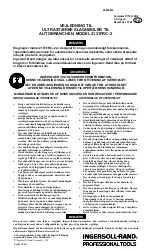
27
USING THE POWER MANAGEMENT SYSTEM
Impact wrenches are not torque wrenches.
Connections requiring specific torque must be checked
with a torque meter after fitting with an air wrench.
POWER
MANAGEMENT
DIAL
(Dwg. TPD1752)
Model 2131FRC–2 Impact Wrench incorporates a Power
Management System that is locked into power output
setting “C”. The Impact Wrench will always operate at
maximum power output in the reverse direction.
This power setting indicator on the rear of this tool is
locked in position “C”. Do not try to force
the
Regulator to another position. The power setting
indicator indicates a power output level, is for
reference only and DOES NOT denote a specific power
output.
The power output can be further reduced in forward
or reverse by using the variable throttle. Also, air
supply systems which do not deliver adequate air
pressure can affect power output at all settings.
MAINTENANCE SECTION
Always wear eye protection when operating or
performing maintenance on this tool.
Always turn off the air supply and disconnect the air
supply hose before installing, removing or adjusting
any accessory on this tool, or before performing any
maintenance on this tool.
Do not test subassemblies unless they are installed in
the tool with the Hammer Case (15) installed and
properly secured to the Motor Housing (19). Failure to
do so could result in injury.
LUBRICATION
Each time a Model 2131FRC–2 Impact Wrench is
disassembled for maintenance and repair or replacement
of parts, lubricate the tool as follows:
1.
If the impact mechanism is not disassembled but
grease needs to be added, inject Ingersoll–Rand
No. 115–1LB Grease through the Hammer Case
Grease Fitting (17). If the impact mechanism is
disassembled, work approximately 14 cc (4.5 tsp) of
Ingersoll–Rand No. 105–1LB or No. Ingersoll–Rand
105–8LB Grease into the impact mechanism. Coat the
Anvil (8) lightly with grease around the Hammer
Case Bushing (16).
Be sure to grease the lug end of the Anvil.
2.
Use Ingersoll–Rand No. 50 Oil for lubricating the
motor. Inject approximately 1 to 2 cc of oil into the
air inlet before attaching the air hose.
DISASSEMBLY
General Instructions
1.
Do not disassemble the tool any further than
necessary to replace or repair damaged parts.
2.
Whenever grasping a tool or part in a vise, always use
leather–covered vise jaws to protect the surface of the
part and help prevent distortion. This is particularly
true of threaded members and housings.
Always use leather–covered vise jaws when
clamping the handle in a vise. Leather will
conform to the shape of the handle and allow the
tool to be held securely. To prevent damage to the
exhaust diffuser, never clamp only the bottom of
the handle.
3. Do not remove any part which is a press fit in or on
a subassembly unless the removal of that part is
necessary for repairs or replacement.
4.
Do not disassemble the tool unless you have a
complete set of new gaskets and O–rings for
replacement.
Disassembly of the Air Wrench
1.
Clamp the handle of the tool in a vise with
leather–covered jaws with the square driver
positioned horizontally.
Avoid excessive clamping pressure which can
damage the Housing and can cause difficulty when
removing the parts.
2.
Unscrew and remove the four Hammer Case Screws
(11).
3.
While lightly tapping on the end of the Anvil (8) with
a plastic hammer, lift off the Hammer Case (15) and
Hammer Case Gasket (18).
The Front End Plate (2) might come off during the
removal of the Hammer Case. Make sure that it
does not drop on the floor or strike a hard or
metallic surface since it might be damaged.
4.
Grasp the Hammer Frame (12) and carefully lift off
the entire impact mechanism, making certain not to
drop the two Hammer Pins (13).
Disassembly of the Impact Mechanism
1.
Set the mechanism, driver end up, on the workbench.
Note the twin hammers within the Hammer
Frame. These are identical, but must be placed in
the Hammer Frame in a certain relationship. Using
a felt–tipped pen, mark
he top T
↑
" hammer and
the bottom hammer B
↑
" with the arrows
pointing upward. Mark both Hammers on the
same end.
2.
With the mechanism sitting upright on the workbench,
slowly rotate the Anvil in a clockwise direction until
it comes up solid.
















































